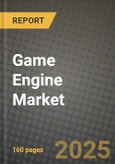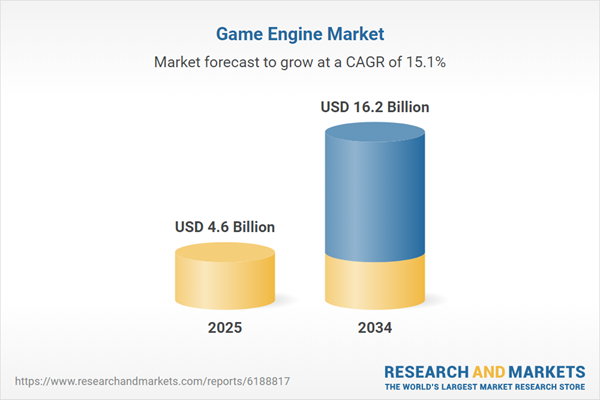Game Engine Market Overview
The Game Engine Market is experiencing rapid growth, driven by the increasing demand for high-quality graphics, immersive gaming experiences, and cross-platform compatibility. Game engines provide the essential framework for developing interactive video games, offering tools for rendering, physics simulation, artificial intelligence, and real-time development. With the rise of gaming across multiple platforms - including PCs, consoles, mobile devices, and virtual reality - the need for versatile and powerful game engines has surged. Major industry players such as Unity, Unreal Engine, and Godot continue to dominate the space, offering developers a wide range of capabilities for both indie and AAA game development. Additionally, advancements in artificial intelligence and machine learning are influencing game design, leading to more dynamic and responsive gaming environments. The increasing adoption of cloud gaming and the expansion of the metaverse have further fueled interest in robust game engine solutions. As gaming continues to evolve beyond traditional entertainment into applications like simulations, virtual training, and augmented reality experiences, the game engine market is poised for sustained expansion in the coming years.The Game Engine Market has seen significant advancements in real-time rendering technologies, AI-driven automation, and accessibility for indie developers. The release of new-generation game engines with enhanced physics, lighting, and ray tracing capabilities has improved the realism and graphical fidelity of modern games. Companies are increasingly integrating AI into game engines to automate animations, NPC behaviors, and procedural content generation, reducing development time and costs. Additionally, the demand for cross-platform game development has driven improvements in game engines that allow seamless transitions between PC, console, and mobile platforms. The growing popularity of no-code and low-code development tools has empowered a broader range of creators, enabling independent developers and small studios to enter the market without extensive programming expertise. Meanwhile, the integration of blockchain technology and NFTs in gaming has led to the development of new monetization models, influencing game engine updates to support decentralized gaming economies. However, challenges such as software licensing costs and the need for extensive computational resources continue to pose barriers for smaller developers.
The Game Engine Market is expected to witness further evolution with a stronger focus on AI-powered game development, cloud-based game engines, and extended reality (XR) integration. AI-driven procedural generation and real-time animation will continue to advance, making it easier for developers to create expansive, lifelike game worlds with minimal manual input. The rise of cloud-based game engines will enable developers to collaborate remotely and reduce hardware dependency, making high-end development tools more accessible to smaller studios. Extended reality applications, including AR, VR, and mixed reality, will drive the demand for more specialized game engines tailored for immersive experiences. Additionally, the continued growth of the metaverse will push game engines to evolve into multi-purpose platforms, supporting digital twins, social interactions, and commerce beyond traditional gaming. The industry is also likely to see more open-source initiatives, as developers seek flexible, cost-effective solutions with greater customization options. As gaming technology advances, the role of game engines will expand beyond entertainment, shaping applications in training, education, and industrial simulations.
Key Insights: Game Engine Market
- AI-Driven Game Development: The integration of artificial intelligence in game engines is streamlining animation, NPC behavior, and procedural content creation, allowing developers to automate complex tasks and improve game realism.
- Expansion of Cross-Platform Development: Game engines are increasingly supporting seamless cross-platform development, allowing developers to build games that run efficiently on PCs, consoles, mobile devices, and even cloud gaming platforms.
- Rise of Cloud-Based Game Engines: Cloud-based development environments are reducing hardware dependency, enabling real-time collaboration among developers and providing access to powerful tools without requiring high-end local systems.
- Growing Influence of Extended Reality (XR): AR, VR, and MR applications are driving demand for game engines capable of creating immersive, interactive experiences beyond traditional gaming.
- Blockchain and Decentralized Gaming Integration: The adoption of blockchain technology, NFTs, and decentralized game economies is influencing game engine capabilities, allowing for new in-game asset ownership and monetization models.
- Increasing Demand for High-Quality Graphics: Gamers expect photorealistic visuals and advanced physics simulations, prompting developers to leverage sophisticated game engines with cutting-edge rendering capabilities.
- Growth of Indie Game Development: The availability of free and low-cost game engines is fueling the rise of independent game developers, expanding the overall market.
- Expansion of Cloud Gaming Services: The rise of cloud gaming platforms is driving the need for optimized game engines that support streaming, reducing hardware limitations for end-users.
- Adoption in Non-Gaming Industries: Game engines are increasingly used in industries such as architecture, automotive, healthcare, and military training for simulations, digital twins, and interactive design applications.
- High Development and Licensing Costs: Advanced game engines often require substantial financial investment, with high licensing fees and computational resource demands making it challenging for small studios to compete with larger developers.
Game Engine Market Segmentation
By Type
- 3D Game Engines
- 2.5D Game Engines
- 2D Game Engines
- Other Types
By Component
- Solution
- Services
By Platform
- Mobile
- Console
- Computer
- Other Platforms
By Genre
- Action and Adventure
- Multiplayer Online Battle Arena (MOBA)
- Real-time Strategy (RTS)
- Role-playing Games (RPG)
- Sandbox
- Shooter (FPS and TPS)
- Simulation and Sports
- Other Genres
By End-User
- Game Development Studios
- Independent Developers
- Academic and Research Institutes
- Other End-Users
Key Companies Analysed
- Amazon.com Inc.
- Epic Games Inc.
- Stride Inc.
- Unity Software Inc.
- Upwork Inc.
- QBurst
- G2
- Crytek GmbH
- Hyperlink InfoSystem
- Appinventiv Technology Pvt. Ltd.
- Belitsoft
- The NineHertz
- Algoworks Solutions Inc.
- Silicon Studio Crop
- VironIT
- Daffodil Software
- Redwerk LLC
- Dev Technosys
- Solarus Thecnologies Inc.
- YoYo Games Ltd.
- Softeq Development Corporation
- GameSalad
- Scirra Ltd.
- Corona Labs Inc.
- Clickteam LLC
- Stencyl
- Delta Engine GmbH
- Argentics
Game Engine Market Analytics
The report employs rigorous tools, including Porter’s Five Forces, value chain mapping, and scenario-based modeling, to assess supply-demand dynamics. Cross-sector influences from parent, derived, and substitute markets are evaluated to identify risks and opportunities. Trade and pricing analytics provide an up-to-date view of international flows, including leading exporters, importers, and regional price trends.Macroeconomic indicators, policy frameworks such as carbon pricing and energy security strategies, and evolving consumer behavior are considered in forecasting scenarios. Recent deal flows, partnerships, and technology innovations are incorporated to assess their impact on future market performance.
Game Engine Market Competitive Intelligence
The competitive landscape is mapped through proprietary frameworks, profiling leading companies with details on business models, product portfolios, financial performance, and strategic initiatives. Key developments such as mergers & acquisitions, technology collaborations, investment inflows, and regional expansions are analyzed for their competitive impact. The report also identifies emerging players and innovative startups contributing to market disruption.Regional insights highlight the most promising investment destinations, regulatory landscapes, and evolving partnerships across energy and industrial corridors.
Countries Covered
- North America - Game Engine market data and outlook to 2034
- United States
- Canada
- Mexico
- Europe - Game Engine market data and outlook to 2034
- Germany
- United Kingdom
- France
- Italy
- Spain
- BeNeLux
- Russia
- Sweden
- Asia-Pacific - Game Engine market data and outlook to 2034
- China
- Japan
- India
- South Korea
- Australia
- Indonesia
- Malaysia
- Vietnam
- Middle East and Africa - Game Engine market data and outlook to 2034
- Saudi Arabia
- South Africa
- Iran
- UAE
- Egypt
- South and Central America - Game Engine market data and outlook to 2034
- Brazil
- Argentina
- Chile
- Peru
Research Methodology
This study combines primary inputs from industry experts across the Game Engine value chain with secondary data from associations, government publications, trade databases, and company disclosures. Proprietary modeling techniques, including data triangulation, statistical correlation, and scenario planning, are applied to deliver reliable market sizing and forecasting.Key Questions Addressed
- What is the current and forecast market size of the Game Engine industry at global, regional, and country levels?
- Which types, applications, and technologies present the highest growth potential?
- How are supply chains adapting to geopolitical and economic shocks?
- What role do policy frameworks, trade flows, and sustainability targets play in shaping demand?
- Who are the leading players, and how are their strategies evolving in the face of global uncertainty?
- Which regional “hotspots” and customer segments will outpace the market, and what go-to-market and partnership models best support entry and expansion?
- Where are the most investable opportunities - across technology roadmaps, sustainability-linked innovation, and M&A - and what is the best segment to invest over the next 3-5 years?
Your Key Takeaways from the Game Engine Market Report
- Global Game Engine market size and growth projections (CAGR), 2024-2034
- Impact of Russia-Ukraine, Israel-Palestine, and Hamas conflicts on Game Engine trade, costs, and supply chains
- Game Engine market size, share, and outlook across 5 regions and 27 countries, 2023-2034
- Game Engine market size, CAGR, and market share of key products, applications, and end-user verticals, 2023-2034
- Short- and long-term Game Engine market trends, drivers, restraints, and opportunities
- Porter’s Five Forces analysis, technological developments, and Game Engine supply chain analysis
- Game Engine trade analysis, Game Engine market price analysis, and Game Engine supply/demand dynamics
- Profiles of 5 leading companies - overview, key strategies, financials, and products
- Latest Game Engine market news and developments
Additional Support
With the purchase of this report, you will receive:- An updated PDF report and an MS Excel data workbook containing all market tables and figures for easy analysis.
- 7-day post-sale analyst support for clarifications and in-scope supplementary data, ensuring the deliverable aligns precisely with your requirements.
- Complimentary report update to incorporate the latest available data and the impact of recent market developments.
This product will be delivered within 1-3 business days.
Table of Contents
Companies Mentioned
- Amazon.com Inc.
- Epic Games Inc.
- Stride Inc.
- Unity Software Inc.
- Upwork Inc.
- QBurst
- G2
- Crytek GmbH
- Hyperlink InfoSystem
- Appinventiv Technology Pvt. Ltd.
- Belitsoft
- The NineHertz
- Algoworks Solutions Inc.
- Silicon Studio Crop
- VironIT
- Daffodil Software
- Redwerk LLC
- Dev Technosys
- Solarus Thecnologies Inc.
- YoYo Games Ltd.
- Softeq Development Corporation
- GameSalad
- Scirra Ltd.
- Corona Labs Inc.
- Clickteam LLC
- Stencyl
- Delta Engine GmbH
- Argentics
Table Information
| Report Attribute | Details |
|---|---|
| No. of Pages | 160 |
| Published | October 2025 |
| Forecast Period | 2025 - 2034 |
| Estimated Market Value ( USD | $ 4.6 Billion |
| Forecasted Market Value ( USD | $ 16.2 Billion |
| Compound Annual Growth Rate | 15.0% |
| Regions Covered | Global |
| No. of Companies Mentioned | 28 |









